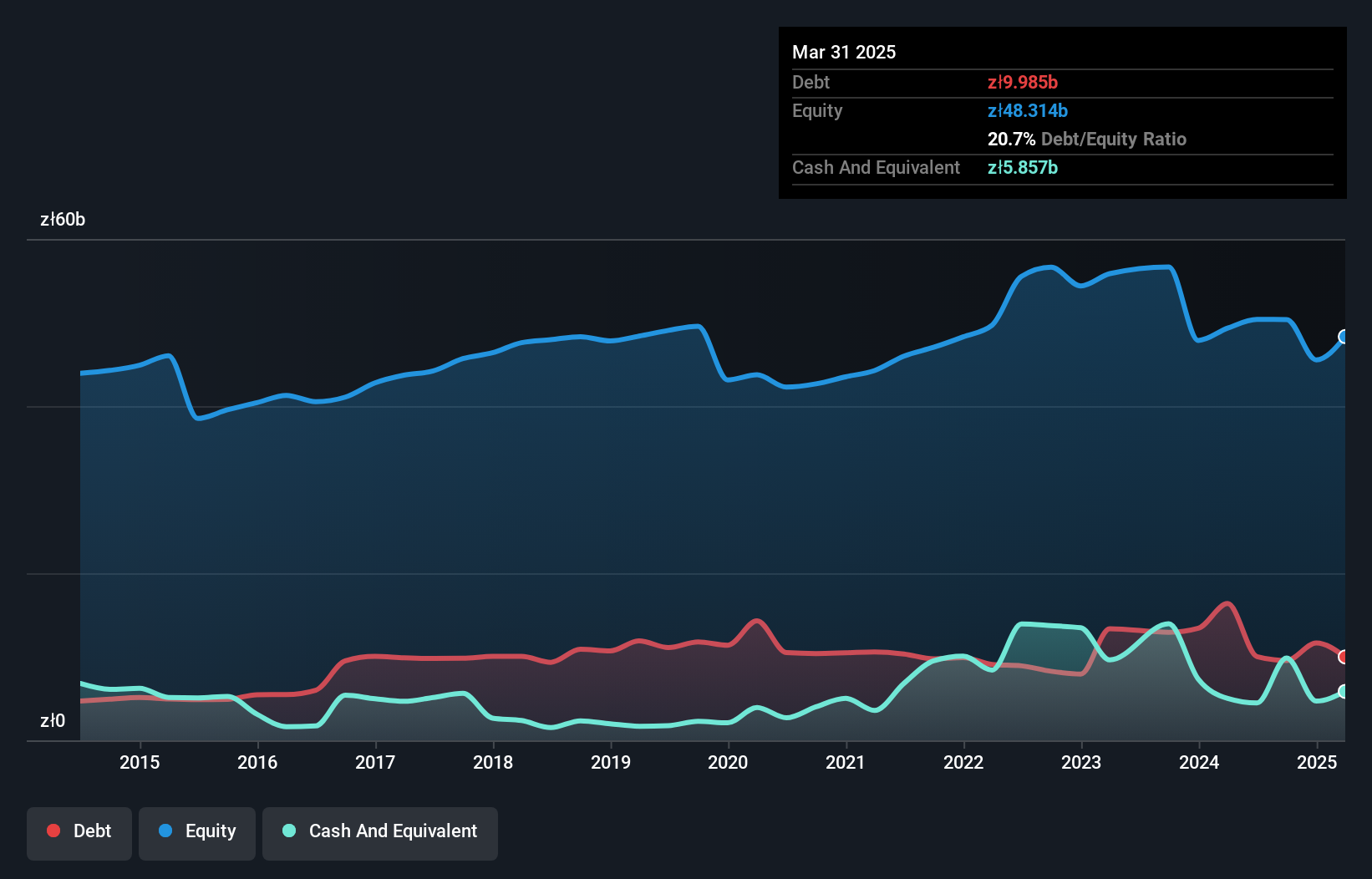Is PGE Polska Grupa Energetyczna (WSE:PGE) Using Too Much Debt?
David Iben put it well when he said, 'Volatility is not a risk we care about. What we care about is avoiding the permanent loss of capital.' So it seems the smart money knows that debt - which is usually involved in bankruptcies - is a very important factor, when you assess how risky a company is. Importantly, PGE Polska Grupa Energetyczna S.A. (WSE:PGE) does carry debt. But the more important question is: how much risk is that debt creating?
When Is Debt A Problem?
Debt and other liabilities become risky for a business when it cannot easily fulfill those obligations, either with free cash flow or by raising capital at an attractive price. Ultimately, if the company can't fulfill its legal obligations to repay debt, shareholders could walk away with nothing. While that is not too common, we often do see indebted companies permanently diluting shareholders because lenders force them to raise capital at a distressed price. By replacing dilution, though, debt can be an extremely good tool for businesses that need capital to invest in growth at high rates of return. The first thing to do when considering how much debt a business uses is to look at its cash and debt together.
How Much Debt Does PGE Polska Grupa Energetyczna Carry?
You can click the graphic below for the historical numbers, but it shows that PGE Polska Grupa Energetyczna had zł9.99b of debt in March 2025, down from zł16.4b, one year before. However, because it has a cash reserve of zł5.86b, its net debt is less, at about zł4.13b.

A Look At PGE Polska Grupa Energetyczna's Liabilities
The latest balance sheet data shows that PGE Polska Grupa Energetyczna had liabilities of zł32.8b due within a year, and liabilities of zł23.6b falling due after that. Offsetting these obligations, it had cash of zł5.86b as well as receivables valued at zł7.98b due within 12 months. So it has liabilities totalling zł42.6b more than its cash and near-term receivables, combined.
The deficiency here weighs heavily on the zł24.1b company itself, as if a child were struggling under the weight of an enormous back-pack full of books, his sports gear, and a trumpet. So we'd watch its balance sheet closely, without a doubt. At the end of the day, PGE Polska Grupa Energetyczna would probably need a major re-capitalization if its creditors were to demand repayment.
See our latest analysis for PGE Polska Grupa Energetyczna
We use two main ratios to inform us about debt levels relative to earnings. The first is net debt divided by earnings before interest, tax, depreciation, and amortization (EBITDA), while the second is how many times its earnings before interest and tax (EBIT) covers its interest expense (or its interest cover, for short). The advantage of this approach is that we take into account both the absolute quantum of debt (with net debt to EBITDA) and the actual interest expenses associated with that debt (with its interest cover ratio).
PGE Polska Grupa Energetyczna's net debt is only 0.32 times its EBITDA. And its EBIT easily covers its interest expense, being 14.2 times the size. So we're pretty relaxed about its super-conservative use of debt. In addition to that, we're happy to report that PGE Polska Grupa Energetyczna has boosted its EBIT by 84%, thus reducing the spectre of future debt repayments. There's no doubt that we learn most about debt from the balance sheet. But it is future earnings, more than anything, that will determine PGE Polska Grupa Energetyczna's ability to maintain a healthy balance sheet going forward. So if you want to see what the professionals think, you might find this free report on analyst profit forecasts to be interesting.
Finally, while the tax-man may adore accounting profits, lenders only accept cold hard cash. So it's worth checking how much of that EBIT is backed by free cash flow. In the last three years, PGE Polska Grupa Energetyczna created free cash flow amounting to 9.0% of its EBIT, an uninspiring performance. For us, cash conversion that low sparks a little paranoia about is ability to extinguish debt.
Our View
We feel some trepidation about PGE Polska Grupa Energetyczna's difficulty level of total liabilities, but we've got positives to focus on, too. To wit both its interest cover and EBIT growth rate were encouraging signs. We should also note that Electric Utilities industry companies like PGE Polska Grupa Energetyczna commonly do use debt without problems. Looking at all the angles mentioned above, it does seem to us that PGE Polska Grupa Energetyczna is a somewhat risky investment as a result of its debt. Not all risk is bad, as it can boost share price returns if it pays off, but this debt risk is worth keeping in mind. Even though PGE Polska Grupa Energetyczna lost money on the bottom line, its positive EBIT suggests the business itself has potential. So you might want to check out how earnings have been trending over the last few years.
Of course, if you're the type of investor who prefers buying stocks without the burden of debt, then don't hesitate to discover our exclusive list of net cash growth stocks, today.
Have feedback on this article? Concerned about the content? Get in touch with us directly. Alternatively, email editorial-team (at) simplywallst.com.
This article by Simply Wall St is general in nature. We provide commentary based on historical data and analyst forecasts only using an unbiased methodology and our articles are not intended to be financial advice. It does not constitute a recommendation to buy or sell any stock, and does not take account of your objectives, or your financial situation. We aim to bring you long-term focused analysis driven by fundamental data. Note that our analysis may not factor in the latest price-sensitive company announcements or qualitative material. Simply Wall St has no position in any stocks mentioned.
 Wall Street Journal
Wall Street Journal